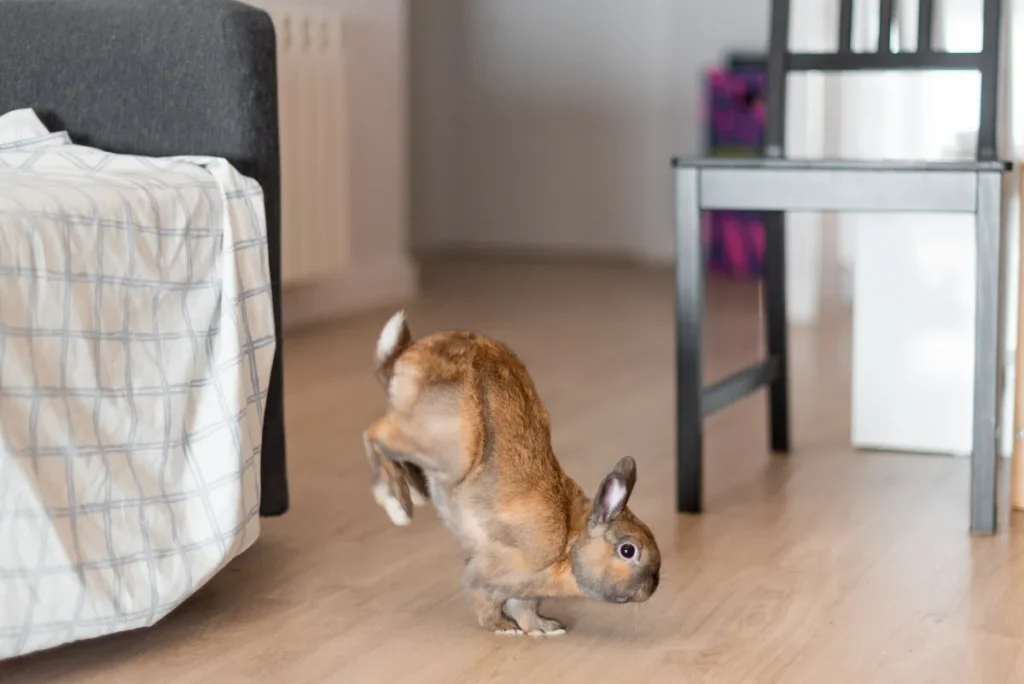When a Solo Bunny Becomes a Reluctant Sibling
In a heartwarming tale of adaptation that recently captivated millions online, a once-solo rabbit’s dramatic reaction to new housemates reveals the complex emotional lives of our furry companions. The viral TikTok video, which has garnered over 2.3 million views since mid-November, shows a gray-and-white rabbit expressing unmistakable displeasure at no longer being the only pet in the household. The bunny, featured on the account @lolo.luca.lily, stands upright while defiantly stomping both feet and fixing his owner with what commenters described as a “death stare.” This pointed display of frustration—stomping is a known warning signal in rabbit communication—struck a chord with viewers, who found the tiny creature’s big emotions both relatable and hilarious. “Imagine being raging with anger & this is all you can do,” wrote one commenter in a sentiment that earned over 51,000 likes, capturing the endearing futility of a small animal’s protest against a significant life change.
While rabbits remain relatively uncommon pets in America—the American Veterinary Medical Association estimates only about 1 million U.S. households (0.7 percent) keep them—those who do share their homes with these animals often develop deep attachments. The viral video demonstrates why: rabbits display remarkably expressive behaviors that make their feelings transparent, even to humans who might not be familiar with lagomorph body language. The bunny’s controlled reaction particularly impressed viewers, with one noting how the rabbit correctly identified “who was responsible and who was to blame” without redirecting aggression toward the newcomers. The owner confirmed this observation with a simple comment: “He’s incredibly smart.” Such moments of cross-species understanding highlight why pet owners form such profound bonds with animals that, despite their inability to speak, communicate their emotions with remarkable clarity.
What makes this rabbit’s protest particularly interesting from a behavioral perspective is how it contrasts with what experts know about natural rabbit social structures. According to the British charity Rabbit Welfare Association & Fund, rabbits are fundamentally social creatures that evolved to live in groups for mutual protection and emotional well-being. Wild rabbits depend on their companions for safety, with multiple sets of ears and eyes better able to detect approaching predators. Solitary rabbits often exhibit stress behaviors precisely because they lack this security network. Research indicates that rabbits may value companionship as much as food—a remarkable finding that places social connection among their most fundamental needs. The stomping bunny’s initial resistance to new companions thus represents not a natural preference for solitude, but rather the territorial response of an animal whose understood social arrangement has been disrupted without consultation.
The situation showcases a common challenge for pet owners: navigating the introduction of new animals into an established household. While humans can understand the long-term benefits of companionship for their pets, animals experience these transitions through a more immediate lens of territory, resources, and established routines. The stomping rabbit’s reaction—directing frustration at the human decision-maker rather than the new rabbits themselves—demonstrates a sophisticated understanding of agency and responsibility. This measured response suggests an animal who, despite his evident displeasure, possesses emotional intelligence and self-restraint. The 2,500+ comments on the video reflect viewers’ appreciation for these qualities, with many anthropomorphizing the rabbit’s feelings in ways that, while perhaps not scientifically precise, capture the genuine emotional complexity of the situation.
Most heartening about this viral moment is that it represents only a chapter in a longer story of adaptation and eventual acceptance. The TikTok account features numerous subsequent videos showing the formerly indignant rabbit now peacefully coexisting with his new companions. This transition from dramatic protest to comfortable cohabitation follows a pattern familiar to many pet owners who have introduced new animals to their households. Initial resistance—sometimes theatrical in its intensity—gradually gives way to tolerance and even affection as animals establish new social norms and hierarchies. The process requires patience from human caretakers, who must respect the time needed for these adjustments while providing reassurance that resources remain sufficient and attention will not be withdrawn. When managed thoughtfully, multi-pet households often result in enriched environments that benefit all animals involved, despite the turbulent transition period.
The extraordinary popularity of this brief rabbit tantrum speaks to something deeper than mere entertainment value. In watching animals navigate changes that mirror human social challenges—sharing space, adapting to newcomers, expressing displeasure without causing harm—viewers recognize patterns that transcend species. The bunny’s foot-stomping protest, his direct “blame” of the responsible human, and his eventual acceptance of new companions create a narrative arc that feels satisfyingly complete. While we must be careful not to project too much human psychology onto animal behavior, these moments of cross-species recognition remind us why pets have become such integral family members in millions of households. They may communicate differently, but their emotional lives unfold with a complexity and authenticity that continually surprises and delights us—sometimes to the tune of millions of views and hundreds of thousands of likes, as one disgruntled but ultimately adaptable rabbit has demonstrated to a captivated online audience.














